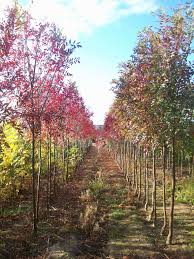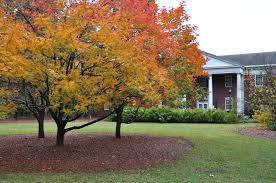Trees for the planet
Keith Munday
Continuing on from last months’ theme of autumn, April is usually the month that we start to notice the beautiful colours of the autumn trees that are dotted around the countryside: shades of vivid yellows, oranges and reds highlighting the gardens that they adorn.
Autumn trees are grown for their beautiful colours, but just as importantly they are also grown for summer shade.
Much care should be taken with the selection of these plants as many are very large trees with invasive roots and need a large parcel of land to grow to their full potential
When I am asked by a customer about their requirements for a tree I suggest they take a drive around the district and have a look at trees in parks and home gardens to see what they might like. Generally, in this district, a number of the shade trees have been growing for many years and have reached their ultimate size. By doing a bit of research before making a decision about your tree, you will know for sure that a particular plant proposed for a spot in the garden will actually fit that site. Autumn colouring trees come in many forms and every one has a particular feature that makes it a bit more special than another variety.
For instance a Claret Ash is a large tree reaching in the vicinity of 15m tall by 12m wide and is more suited to a large space well away from buildings. Its main feature is the beautiful claret coloured foliage in autumn. On the other hand a Chinese Pistacia is a smaller upright tree to 8m by 4m wide with beautiful orange red foliage and is suited to a smaller garden and can be closer to a building.
Deciduous trees also have different moisture requirements so planting moisture requiring plants in a dry garden can cause issues throughout summer or drier periods. An example of this is Silver Birch that prefers a higher level of moisture particularly in summer compared to a Desert Ash that prefer and copes better with a drier situation.
 When trees are used in the overall landscape of a garden the siting is of absolute importance. A large tree can dominate a garden and can often restrict the growth of colourful shrubs that require full sun. If you have a small yard choose a small tree to place on the north or the western side of the house.
When trees are used in the overall landscape of a garden the siting is of absolute importance. A large tree can dominate a garden and can often restrict the growth of colourful shrubs that require full sun. If you have a small yard choose a small tree to place on the north or the western side of the house.
With the movement of population to small acreages I am often asked what trees I can suggest for a driveway. Again careful planning of the species used in this situation is very important. Availability of water; animal protection, and as the tree matures, allowing enough room when the tree reaches maturity to allow high vehicles like cattle trucks or furniture removal vans to be able to access the driveway.
In this case use more upright species like some of the newer varieties of ornamental pears. These are more suited as they give height with the avenue effect without taking up too much room. Trees from nurseries are either container grown or bare rooted. At this time of the year you will only find container grown trees in nurseries and although these might be a bit more expensive the tree can actually be seen with leaves on and is then generally alive and kicking.
Care must be taken later in the season if you wait for the bare root trees. Ensure you choose a tree that treated with care and has not been allowed to dry out. Otherwise the ability to re-shoot is compromised.
Commence the site preparation with hole digging and composted manure added to the soil to give the trees a great start.


